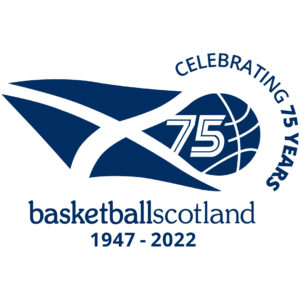The first decade for basketballscotland (known at the time as the Amateur Basketball Association of Scotland) was relatively quiet. It was in the 1960s that the game exploded into life in Scotland. An important driver in this activity was the American influence emanating from the military using Scotland as a base for some of their Cold War operations. Unofficial tournaments hosted by American Air Force personnel, stationed at the Royal Air Force camp at Edzell, and the US Navy at Dunoon were precursors to a league competition and structure that still influences the current day season. Progress in the domestic game was complimented by excitement on the international scene.
Scotland Men bring joy through effort and a popular TV appearance.
The 1960s started with an inspirational effort by the Scotland Men’s Team to win a four-nations tournament featuring England, Wales and Ireland. The competition doubled as a trial for Great Britain selection. Scotland were rewarded with five players selected for the Great Britain team (Joe Dixon, John Fisher, Ken Johnston, Tom McTear and Charlie Robinson).
The initiative shown by the Amateur Basketball Association of Scotland (ABAS) to host the event in Kirknewton, Midlothian, led to the formation of the Four Countries Committee, a predecessor to the British and Irish Basketball Federation.
Later in the decade, the Scotland Men’s National Team embarked on a tour of the East Coast of the United States and Canada. As part of their adventure American TV host Ed Sullivan invited the team onto live television. The show was broadcast in 13 million American homes and gave the squad nationwide exposure. During the tour, they also visited the birthplace of basketball, Springfield, Massachusetts, to pay tribute to Dr James Naismith who had Scottish roots.
Teamwork too much for England
Scotland Women had a statement victory to kick off their decade. Travelling down to Manchester, they were emphatic victors against the Auld Enemy in the first official game between the two rivals. A score line of 68-30 reflected Scotland’s superiority as a team. For more information on the development of the Women’s game, please read: Start of the Women’s Game
Resilience rewarded in Tokyo as the wheelchair game evolves
Further Scottish success was evident in the wheelchair game. John Clark became the first Scot to represent the Great Britain wheelchair basketball team, taking to the floor at the Tokyo 1964 Paralympic Games. The team battled their way to the final and John and his teammates left Japan with a silver medal.
Great Britain were back in action at the International Games, Stoke Mandeville in 1970. The team featured a first cap for Michael McCreadie who would go onto a distinguished career as a player and coach in the wheelchair game.
Domestically wheelchair basketball started to develop after the creation of the Scottish Paraplegic Association. From its inception in 1966, wheelchair basketball was identified as a key sport.
The game goes from strength to strength
As the 1960s progressed, domestic basketball grew in popularity. From the unofficial tournaments at American military bases, a more structured league was born. ABAS sanctioned the Scot/Am (Scottish American) league that featured Scottish teams (Hornets, Boroughmuir, the Pearce Institute in Glasgow and St Michael’s in Dundee) alongside teams from the American military bases at Dunoon and Edzell.
With an influx of teams from across Scotland signing up to compete, and the US military bases closing, ABAS created a national league structure to run alongside the well-established Scottish Cup. Competitions were created for male, female and youth teams.
There was no doubting who the dominant team was. From 1965-66 Boroughmuir Blaze, led by the inspirational and charismatic Bill McInnes OBE, won the Scottish Cup a staggering 10 out of the next 11 seasons. This included winning the Cup an astonishing nine consecutive times.
Blaze were also making history on the continent. On the 29th of October 1967, they were the first Scottish and British team to compete in the FIBA European Cup. Their opponents were the great Real Madrid, the Champions of Europe at the time. Although Madrid took the win at Murrayfield Ice Rink, the attitude, work rate and general performance from Boroughmuir put Scotland on the European basketball map. It would create the pathway for further Scottish successes on the European stage within the coming decades.
As the 1960s clicked into the 1970s, Edinburgh was preparing to host the 1970 Commonwealth Games. Consequently, the Meadowbank Sports Centre was built. It was at these Games that Scotland first competed as an international wheelchair basketball team.
Prior to the Games, Scotland took on England in the impressive new basketball arena. It was fantastic that Scotland won, but, of more importance, was the impact facilities like Meadowbank had on basketball in Scotland. The size of these new venues allowed all Scottish Cup Finals to take place over the course of a weekend, turning Cup Finals into an exciting season finale. Although no longer at Meadowbank, the tradition continues to this day with Cup Finals Weekend featuring as one of the biggest events in the basketballscotland calendar.
Thank you to Alex O’Hara and Ken Johnston for providing background information surrounding this article.












